This is the first of two articles for an on-going project the author is undertaking regarding a forgotten, but noteworthy educational cartoon series produced by General Motors. This first part takes a look at the first installment, “The ABC of Internal Combustion Engines” produced by Herb Lamb Productions, and next week’s second part will look at the final three cartoons that were made by the Sound Masters company.

PART 1: Herb Lamb’s “The ABC Of Internal Combustion”
There are a number of animated films historians and fans of golden age era cartoons consider significant to animation history such as Steamboat Willie, What’s Opera Doc, Rooty Toot Toot etc. and numerous others from Walt Disney, Chuck Jones, Tex Avery, UPA, etc.. One particular cartoon that is not yet on this list of classics but is a strong candidate for consideration, is an extremely unique 1948 educational cartoon entitled The ABC Of Internal Combustion Engines.
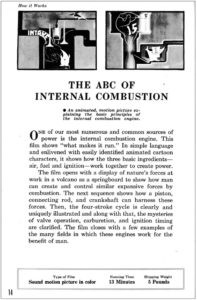 Produced by the studio of a former Disney production manager named Herb Lamb, the cartoon was made for General Motors and created to visually breakdown how an engine’s main source of power, internal combustion works with air, fuel and ignition. While the subject matter doesn’t sound the most exciting, what makes the cartoon unique is how it teaches the subject by using humor and it’s extremely high production values which are on the same level as an animated film from Disney, Warner Brothers, or M-G-M. Unfortunately The ABC of Internal Combustion Engines has fallen into extreme obscurity due to several factors, the main being the cartoon never saw a release theatrically, the home movie market or on television and it’s exhibition was limited only to group showings. It doesn’t help either the cartoon was barely mentioned outside of General Motors PR material nor did it receive mention in trade papers such as The Hollywood Reporter, Variety, or (surprisingly) Business Screen Magazine. This obscurity is unfortunate as the author considers it to be one of the greatest documentary films from this era, and today serves as an exceptional example of how to take a boring complex procedure and effectively teach it in an entertaining manner.
Produced by the studio of a former Disney production manager named Herb Lamb, the cartoon was made for General Motors and created to visually breakdown how an engine’s main source of power, internal combustion works with air, fuel and ignition. While the subject matter doesn’t sound the most exciting, what makes the cartoon unique is how it teaches the subject by using humor and it’s extremely high production values which are on the same level as an animated film from Disney, Warner Brothers, or M-G-M. Unfortunately The ABC of Internal Combustion Engines has fallen into extreme obscurity due to several factors, the main being the cartoon never saw a release theatrically, the home movie market or on television and it’s exhibition was limited only to group showings. It doesn’t help either the cartoon was barely mentioned outside of General Motors PR material nor did it receive mention in trade papers such as The Hollywood Reporter, Variety, or (surprisingly) Business Screen Magazine. This obscurity is unfortunate as the author considers it to be one of the greatest documentary films from this era, and today serves as an exceptional example of how to take a boring complex procedure and effectively teach it in an entertaining manner.
The exact history of The ABC Of Internal Combustion Engines is not entirely known to the author at the moment and can only be speculated by observing film history pertaining to General Motors. It’s history apparently goes back to 1944 when General Motors contracted the Walt Disney Studios to produce “The ABC of Hand Tools”. Prior to World War II, General Motors’ animation projects were usually contracted out to the Jam Handy Organization (i.e. 1935’s Down The Gasoline Trail). During World War II however, Jam Handy was tied up mass producing films for the war effort making their involvement with an animated tool program for General Motors impossible.
Walt Disney on the other hand was interested in producing industrial films for clients to generate lost revenue from the war, and apparently saw potential in General Motors’ project. Disney’s program would consist of two fifteen minute cartoons and a souvenir booklet, and used the humorous ventures of ‘Primitive Pete’ (who made his debut in the 1943 Academy Award nominated cartoon Reason And Emotion) to teach the ‘ABCs’ of how to properly use hand tools. The Disney program was completed in 1946 and General Motors issued it non-theatrically for group showings in factories and schools where it received positive reception.
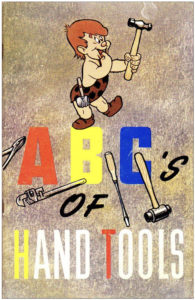 The success of The ABC’s of Hand Tools apparently prompted General Motors to want more non-theatrical training films for group and classroom showings that played out as entertaining Disney-ish, Hollywood styled cartoons. For their next animation project General Motors decided to adapt their acclaimed 1944 booklet “A Power Primer” into a series of motion picture cartoons that could visually breakdown the complex world of engine operation in a humorous, entertaining way. While General Motors was excited about another Disney-ish educational program, Walt Disney did not apparently share this enthusiasm. By the time “The ABC of Hand Tools” was completed, Disney’s passion for producing sponsored industrial films for anybody, not just GM, had faded as he found “it’s scope limited” (as stated in the February 1946 issue of Film World & AV News); Disney is reported to have discontinued his industrial and educational film division in November/December of 1945. (One interesting observation is that it took over one year for Disney to deliver The ABC Of Hand Tools to General Motors. When compared to other Disney cartoons of the same time frame it does not quite feel like what a Disney film could be). Following the discontinuation of his industrial division, Disney recommended former clients and potential new ones to the studios established by former Disney employees whom Walt had a lot of respect for, such as John Sutherland and Herb Lamb. General Motors was apparently recommended to Herb Lamb’s studio – Herb Lamb Productions.
The success of The ABC’s of Hand Tools apparently prompted General Motors to want more non-theatrical training films for group and classroom showings that played out as entertaining Disney-ish, Hollywood styled cartoons. For their next animation project General Motors decided to adapt their acclaimed 1944 booklet “A Power Primer” into a series of motion picture cartoons that could visually breakdown the complex world of engine operation in a humorous, entertaining way. While General Motors was excited about another Disney-ish educational program, Walt Disney did not apparently share this enthusiasm. By the time “The ABC of Hand Tools” was completed, Disney’s passion for producing sponsored industrial films for anybody, not just GM, had faded as he found “it’s scope limited” (as stated in the February 1946 issue of Film World & AV News); Disney is reported to have discontinued his industrial and educational film division in November/December of 1945. (One interesting observation is that it took over one year for Disney to deliver The ABC Of Hand Tools to General Motors. When compared to other Disney cartoons of the same time frame it does not quite feel like what a Disney film could be). Following the discontinuation of his industrial division, Disney recommended former clients and potential new ones to the studios established by former Disney employees whom Walt had a lot of respect for, such as John Sutherland and Herb Lamb. General Motors was apparently recommended to Herb Lamb’s studio – Herb Lamb Productions.

Herb Lamb Productions was established in 1946 by former Disney production manager Herbert Lamb and a former Disney animator named Tom Codrick. Lamb resigned from Disney in 1941 as he disagreed with how Walt reorganized his studio following the May 1941 strike (for the record, he apparently supported Walt during it), while Codrick’s departure came in the early 1940s when he joined the armed forces. Their studio would only be in operation for two years as it closed in early 1948 and declared bankruptcy shortly after. During the two years of operation Lamb and Coldrick produced at least one unreleased theatrical cartoon entitled “Three Blind Mice”, and a handful of well received industrial films. Two of these positively received industrial productions were:
Design for Arc Welded Structures, a non-theatrical animated Technicolor training film produced for Lincoln Electric Company.
Play Ball Son, a live-action and animated Technicolor adaption of Joe Cronin’s Baseball book of the same name, that was sponsored by Ford Motor Company.

Images from Herb Lamb’s Lincoln Electric production of “Design For Arc Welded Structures” , published in the June 1947 issue of Popular Science magazine.
In November of 1946 Film World and AV News ran an announcement that General Motors had ‘ordered’ 300 prints of five cartoons from Herb Lamb Productions based on the “A Power Primer” booklet. These five films to be produced consisted of “Combustion Creates Power”, “The ABC Of The Automotive Engine”, “The ABC of The Diesel Engine”, “The ABC of the Airplane Engine”, and “The ABC of Ignition”. Each cartoon was to be shot on 35mm film in Technicolor and then reduced to 16mm Technicolor prints with variable density sound tracks.
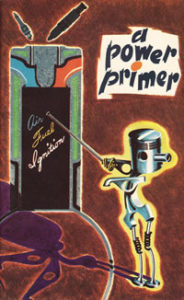 “Combustion Creates Power” would be the only one of the five “Power Primer” cartoons to be produced by Lamb’s studio; it was completed and released as The ABC Of Internal Combustion Engines. As hinted by the announcement, production on the first cartoon started in late 1946 and was completed by 1948, as it was registered for copyright that year. With the exception of Herb Lamb and Tom Codrick, it’s unfortunately a bit of a mystery who else worked on the film or provided it’s narration. Some viewers will notice that it has a somewhat Disney feel to it; it is possible that when Lamb and Codrick started their studio, several Disney animators who worked in Disney’s industrial division went to work for Lamb’s studio. (One thing that is known, is that the film was NOT sub-contracted by Disney nor was it a Disney production as indicated by the copyright records or other General Motors announcements).
“Combustion Creates Power” would be the only one of the five “Power Primer” cartoons to be produced by Lamb’s studio; it was completed and released as The ABC Of Internal Combustion Engines. As hinted by the announcement, production on the first cartoon started in late 1946 and was completed by 1948, as it was registered for copyright that year. With the exception of Herb Lamb and Tom Codrick, it’s unfortunately a bit of a mystery who else worked on the film or provided it’s narration. Some viewers will notice that it has a somewhat Disney feel to it; it is possible that when Lamb and Codrick started their studio, several Disney animators who worked in Disney’s industrial division went to work for Lamb’s studio. (One thing that is known, is that the film was NOT sub-contracted by Disney nor was it a Disney production as indicated by the copyright records or other General Motors announcements).
The end result of The ABC Of Internal Combustion Engines is a brilliant film that effectively teaches a complex topic in a humorous manner easy for anyone to understand. To teach the concept of internal combustion, the film begins with a description of how internal combustion has shaped the world to modern times, and then breaks down the concept by personating it’s three main components Air, Fuel, and Ignition as goofy cartoon characters. The characters who silently interact with each other and with detailed technical drawings and fonts, use slapstick humor to demonstrate how internal combustion works.

The three piston pushers: Air, Fuel, and Ignition.
The film also shows with the characters how four-cycle engines work and how the different components of valve operation, carburation, and ignition timing all contribute to the concept. One of the running jokes throughout the visualizations features Ignition obsessively trying to blow up Air and Fuel. The film wraps up with a beautifully illustrated montage of how internal combustion has contributed to the technological progress of society. This is all accompanied by rather humorous but informative narration and also a fun over the top musical score to enhance the comedy and education.
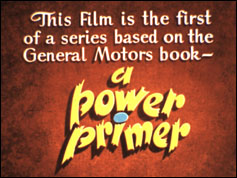 General Motors began loaning 16mm prints of the cartoon in 1948 and prints were only available for scheduled group showings in schools and also in civic club meetings. It was not released theatrically, not shown on television, nor sold on the home movie market. The prints were loaned without any charge and borrowers paid only return postage, who were expected to return the film on time with an attendance report card. The attendance report card, reported important information back to General Motors such as how the film was used and the audience’s overall thought of it. An excerpt from the 1956-1957 General Motors Film Catalog (posted below) shows how “The ABC of Internal Combustion” along with other General Motors library films were loaned and what the responsibilities of the exhibitor were:
General Motors began loaning 16mm prints of the cartoon in 1948 and prints were only available for scheduled group showings in schools and also in civic club meetings. It was not released theatrically, not shown on television, nor sold on the home movie market. The prints were loaned without any charge and borrowers paid only return postage, who were expected to return the film on time with an attendance report card. The attendance report card, reported important information back to General Motors such as how the film was used and the audience’s overall thought of it. An excerpt from the 1956-1957 General Motors Film Catalog (posted below) shows how “The ABC of Internal Combustion” along with other General Motors library films were loaned and what the responsibilities of the exhibitor were:
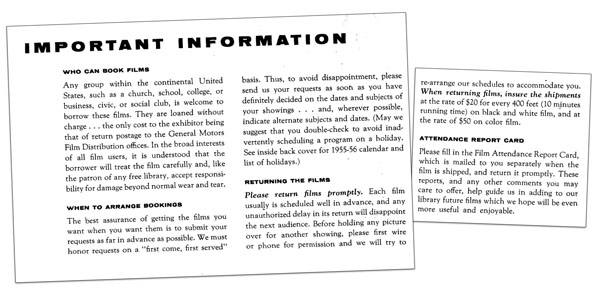
Apparently report cards spoke highly of “The ABC of Internal Combustion” as General Motors would not update the cartoon until the 1970s, giving it an over twenty year run! During it’s time, GM accurately advertised the film as ‘an animated motion picture explaining the basic concepts of the internal combustion engine’ ‘in simple language and enlivened with easy identified animated cartoon characters it shows how the basic ingredients – air, fuel, and ignition, – work together to create power’. Why the film was eventually updated in the 1970s probably had nothing to do with a decline in it’s popularity, but more from a technology standpoint. Unfortunately the three characters Air, Fuel, or Ignition would not be present for the 1970s remake (nor any remake of the ‘ABC’ films).
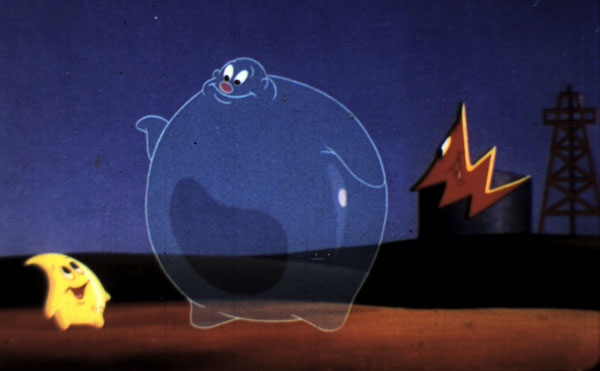
Following it’s discontinuation, General Motors sold off the prints of The ABC of Internal Combustion Engines to schools and film collectors, some of whom continued to use it as a teaching aid well into the 1980s. Sadly despite being used by some individuals, the film fell into obscurity and became unknown to many film historians or film buffs. Fortunately, the cartoon did go into the public domain which has given it an opportunity for a second life. In the mid-1990s it finally saw it’s first mainstream VHS and DVD release from film collector Mike Vraney, who included it on one of his enjoyable Something Weird Video cartoon compilations. While his collection presented the cartoon as is with no historical background, it did give The ABC of Internal Combustion Engines a much deserved video release and has contributed to it’s survival; it was this release that made the author aware of this incredible film.
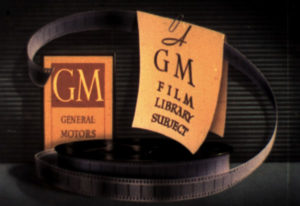 In 2018, to contemporary audiences the cartoon is an exceptional example of how to make an entertaining technical presentation. While it does have a niche audience, students studying engines, it’s production values should be observed and studied by those pursuing filmmaking and/or (PowerPoint/Keynote) presentation design for how it effectively breaks down a complex procedure in an entertaining and understandable way. While the animated antics of Air, Fuel, and Ignition certainly contribute to this, the film’s other two noteworthy qualities that make this possible are it’s storytelling and it’s use of graphic and font design. From a storytelling aspect, the film is directly to the point telling the story of a concept, it’s basic principals, how it contributes to a cause and why viewers should care. It smoothly transitions from one theme to another in a natural non-confusing manner and the narrator who tells this story talks to the viewer in a simple, and respectable way. In terms of graphic design, the film combines beautifully illustrated and accurate technical drawings with a wide range of fonts that appropriately fit the visualizations. One excellent example of this is the sequence demonstrating the four cycle engine, in which several fonts animate ‘intake’, ‘compression’, ‘Combustion’, and ‘exhaust’.
In 2018, to contemporary audiences the cartoon is an exceptional example of how to make an entertaining technical presentation. While it does have a niche audience, students studying engines, it’s production values should be observed and studied by those pursuing filmmaking and/or (PowerPoint/Keynote) presentation design for how it effectively breaks down a complex procedure in an entertaining and understandable way. While the animated antics of Air, Fuel, and Ignition certainly contribute to this, the film’s other two noteworthy qualities that make this possible are it’s storytelling and it’s use of graphic and font design. From a storytelling aspect, the film is directly to the point telling the story of a concept, it’s basic principals, how it contributes to a cause and why viewers should care. It smoothly transitions from one theme to another in a natural non-confusing manner and the narrator who tells this story talks to the viewer in a simple, and respectable way. In terms of graphic design, the film combines beautifully illustrated and accurate technical drawings with a wide range of fonts that appropriately fit the visualizations. One excellent example of this is the sequence demonstrating the four cycle engine, in which several fonts animate ‘intake’, ‘compression’, ‘Combustion’, and ‘exhaust’.
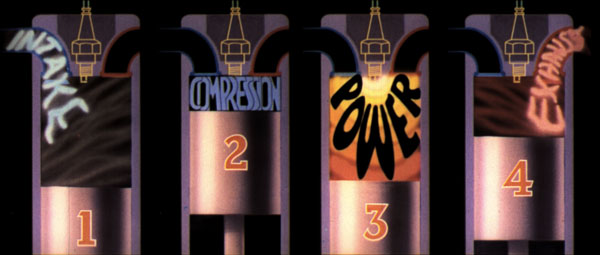
The author has shown The ABC Of Internal Combustion Engines to several people at Toastmasters meetings and community access stations as an example of presentation design and to emphasize the idea that any boring subject matter can be potentially entertaining. Hopefully readers will agree after viewing the cartoon.
A special thank you to Mitchell Dakelman, Don Yowp, and Ray Pointer for their help with the production of this article, and also to the late Mike Vraney for making the film available. Further acknowledgment is also given to the Media History Digital Library and to Mark Arnold for his 2006 Hogans Alley article “The Tools That Time Forgot” that discusses “The ABC of Hand Tools”.
NEXT WEEK: The Sound Masters sequels.


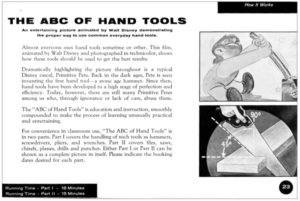
 Jonathan A. Boschen is a professional videographer and video editor, who is also a film and theatre historian. His research deals with pre-1970s movie theaters in New England and also film history pertaining to the Jam Handy Organization, Frank Goldman, Ted Eshbaugh, Jerry Fairbanks, and industrial films. (He is a huge fan of industrial animated cartoons!). Currently, Boschen is working on a documentary on the iconic Jam Handy Organization.
Jonathan A. Boschen is a professional videographer and video editor, who is also a film and theatre historian. His research deals with pre-1970s movie theaters in New England and also film history pertaining to the Jam Handy Organization, Frank Goldman, Ted Eshbaugh, Jerry Fairbanks, and industrial films. (He is a huge fan of industrial animated cartoons!). Currently, Boschen is working on a documentary on the iconic Jam Handy Organization.






















































There’s some excellent effects animation here, especially on the opening shots of the volcanoes, which remind me of the “Rite of Spring” segment of Fantasia. The character designs are pretty cute too. Thanks for posting.
This is really great stuff. Love the old industrial films. I can’t wait to see more of your documentary.
Much later, in the 1980’s, GM made (or had made) a short educational animated film on various engine technologies. I think it was either for the now defunct AutoWorld in Flint MI or for the GM pavilion at EPCOT, but it may even have been for one of the 1980’s World’s Fairs. I think it was even shown in a small scale 3D system. I believe it was called, “The Hydrogen Engine”. It was no more than 5 to 10 minutes long. It had a proponent for each. It ended with the Hydrogen engine exploding. I can’t find record of it on IMDB or a copy anywhere. Any thoughts on where to look?